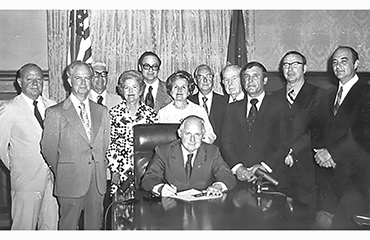Editor’s Note: During the Sesquicentennial Celebration of Lander University, this series will take us into the University’s archives for photos and brief stories about the college and its growth.

S.C. Gov. John C. West, seated, signed legislation in 1972 for Lander College to become a state-supported institution of higher education. Photo from Lander University Archives
In the summer of 1972, S.C. Gov. John C. West officially signed legislation to make Lander College, the forerunner of Lander University, a state-supported institution of higher education.
The “Act to Authorize the Transfer of Lander College to the State of South Carolina” authorized the state “to acquire all that property known as Lander College, real, personal and mixed, from The Lander Foundation, a political subdivision created by Act 110 of 1951.”
The change was momentous: It came 100 years after the school’s founding in 1872 as the Williamston Female College.
S.C. Sen. John Drummond, along with Marion Carnell and James Moore, both of the S.C. House of Representatives, were leading advocates for the change.
Dr. E. Don Herd Jr., then president of Lander, praised the move as helping area students from low-income families achieve a college education.
“They can’t go to college anywhere,” he said, noting that only 27 percent of college-age youths from the Greenwood area sought college or university degrees.
Statewide, Herd said, 33 percent of young people the same age were pursuing college degrees.
Although the move for state-support status encountered some resistance, Drummond said, “… the senators realized our case had merit and that Lander is unique.”
The college’s governing body maintained the operation of the school until July 1, 1973, at which time a State College Board of Trustees was formed to lead Lander.
In 1992, Lander again would undergo a name change. Act 272 of the S.C. General Assembly authorized Lander College to become Lander University. John Johnston, chair of Lander’s Board of Trustees, said, “Lander has always built on its traditions. The change from college to university status reflects the growth in enrollment and academic programs experienced in recent years.”
Lander President Dr. Larry Jackson, who was retiring after a 19-year presidency, looked ahead to the future of the school, and said, “A vital, creative college is a living organism, forever growing, changing, reaching out, and serving new constituencies.”